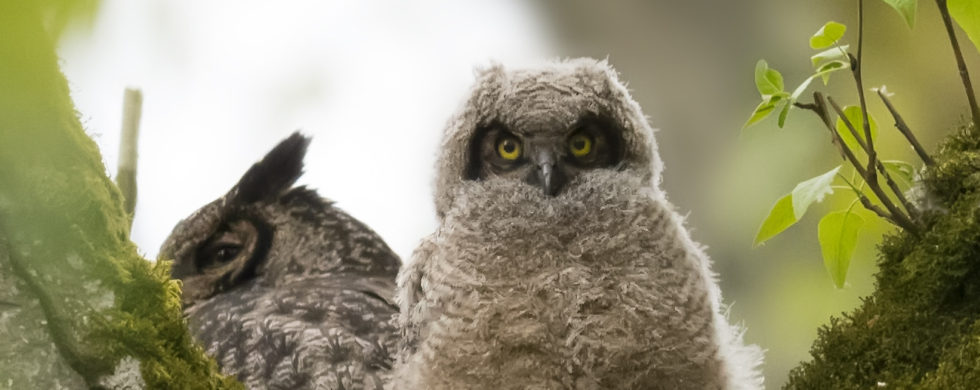
30
2017Great Horned Owl
Shot of the Month – September 2017
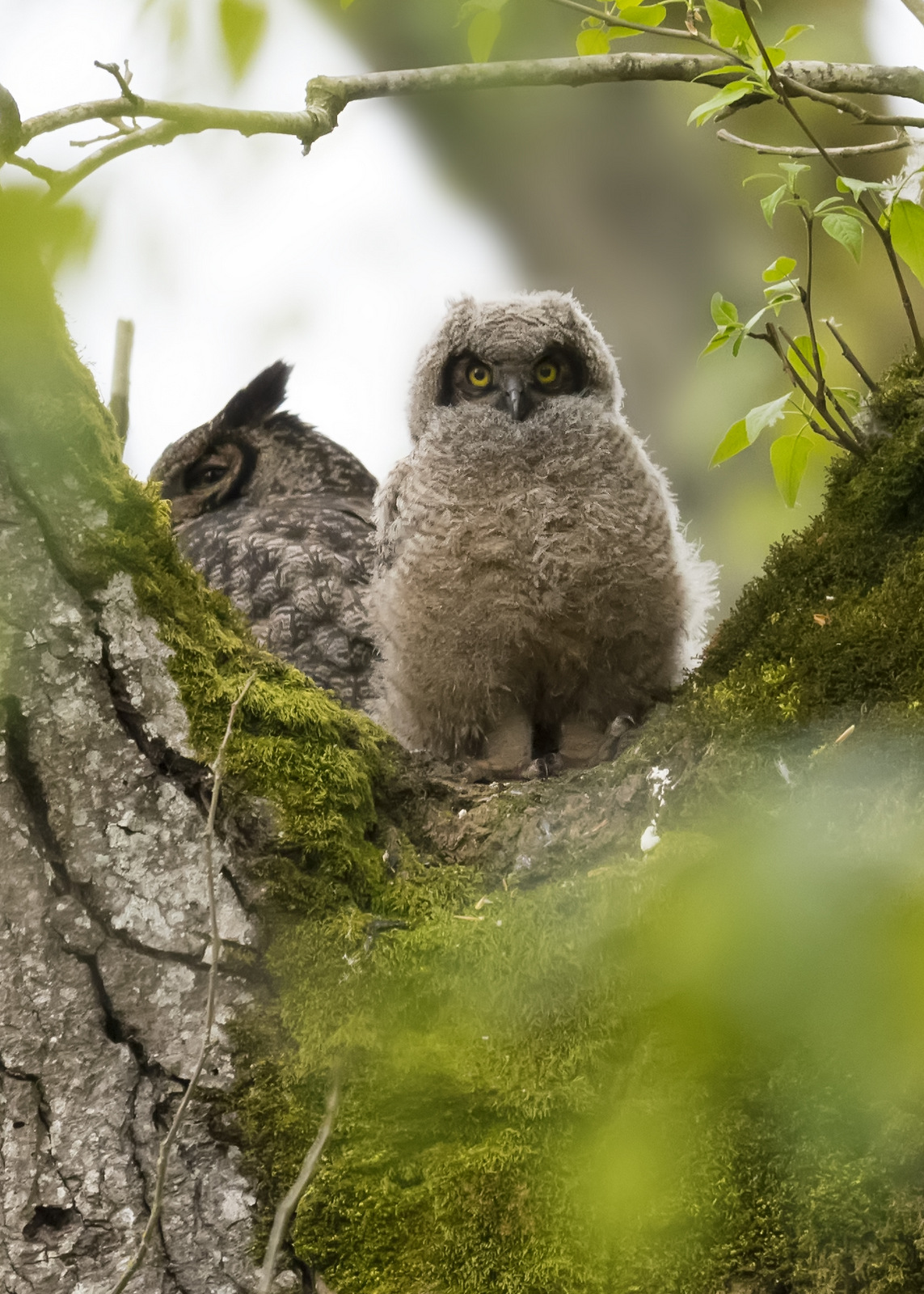 Despite all my early morning gallivanting in the woods over the years I had never seen a Great Horned Owl (GHO). I find this even more astounding having recently learned that the GHO is THE most common owl in America. If you live in North America there is probably a Great Horned Owl family living in a tree not far from your house. These owls are incredibly adaptable and can live just about anywhere and can be found from the Arctic to South America.
Despite all my early morning gallivanting in the woods over the years I had never seen a Great Horned Owl (GHO). I find this even more astounding having recently learned that the GHO is THE most common owl in America. If you live in North America there is probably a Great Horned Owl family living in a tree not far from your house. These owls are incredibly adaptable and can live just about anywhere and can be found from the Arctic to South America.
The GHO is a big bird – it is the second heaviest owl in North America and as such is a fierce predator and can take prey much larger than itself. These owls normally begin nesting weeks or even months before other raptors – here in Washington State GHO chicks typically appear in February! Keeping eggs warm during the winter is very difficult. Why take such a risk and not just wait till later in the spring like most birds? Well, given the large size of the species, the chicks need more time to grow and develop into young adults. Also, young GHOs must master complex hunting maneuvers. By hatching early in the spring they maximize the time available to practice flying and improve their hunting skills while the weather is mild and prey is abundant (source).
GHOs typically nest in trees such as cottonwood, juniper, beech, pine, and others. They usually adopt a nest abandoned by another large bird, but they also use cavities in live trees, dead snags, deserted buildings, cliff ledges, and human-made platforms.
Fun fact: As a rule, no owl species builds its own nests. I didn’t know that, either. (source)
This year I went from never seeing a GHO owl to having the good fortune of finding not one, but two GHO nests.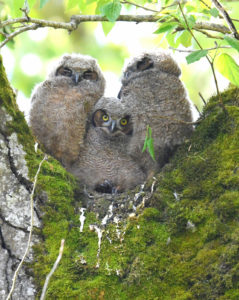 In Nisqually NWR (an hour south of Seattle) I found an owl family with three chicks. As you can see, in their youth they are adorable fluff balls. The Nisqually family was raised in a cavity in the tree though from time to time the chicks would come out and stand on this fork in the trunk and give us a view. Here to the right, you can see one of the rare moments where all three chicks can be seen at once.
In Nisqually NWR (an hour south of Seattle) I found an owl family with three chicks. As you can see, in their youth they are adorable fluff balls. The Nisqually family was raised in a cavity in the tree though from time to time the chicks would come out and stand on this fork in the trunk and give us a view. Here to the right, you can see one of the rare moments where all three chicks can be seen at once.
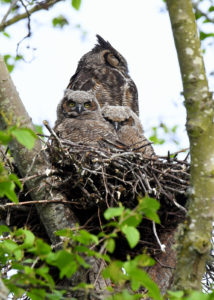 In the Skagit Wildlife Area (about an hour north of Seattle) I found this family on the left with two chicks.
In the Skagit Wildlife Area (about an hour north of Seattle) I found this family on the left with two chicks.
Despite the wide distribution of these wonderful owls, we rarely see these denizens of the night. Many people do hear their classic owl Hoots either early in the morning or at night.
If you are fortunate enough to find a GHO nest do take care. GHO adults, monogamous for life, are dedicated parents and both males and females will stand guard over the chicks. The male typically roosts nearby, out of sight, but from a location where he can watch over the nest. The female alone incubates the eggs while the male will go off to hunt and bring food back for his mate. GHOs will defend their nest with great vigor and they have been known to attack humans that wander too close to a nest.
You’ve been warned…
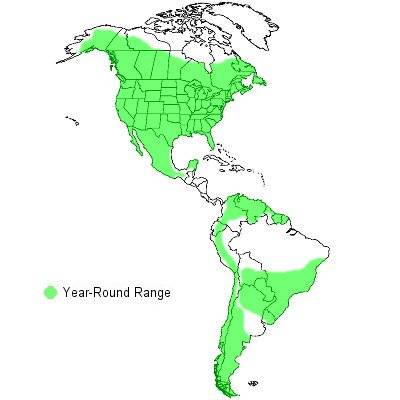
Great Horned Owl Range (Source)
Until next month
Nikon D500, Nikon 600 mm f/4, 1/500 sec, ISO 2200, +2 EV

Joyce Palmer
Thanks for this, Michael. I enjoy your photography and your writings are an added bonus!
Michael
Thanks, Joyce. Glad you enjoyed it!!
Dazebra
Hi would the void in South America be due to too tree snakes?
Michael
Hmmn, interesting question. From I can find, the areas where GHO are not found in South America is where the Amazon rain forest is thickest. Seems that GHO are not fond of that hot, humid, dense environment. I think they prefer areas with more open space to hunt. Given their fierce nature I don’t think that they would be afraid of a tree snake and would find it a tasty meal. 🙂
Joann Lee Sites
Love your photos. They are amazing!!
Michael
Thanks! 🙂
Mitch Moraski
Great images Michael!! Continued success.
Michael
Thanks buddy! Looking forward to getting you out here for some shooting…!
Abigail Price
Great little fluff balls! Have missed your pictures!
Abby
patty mountjoy
Michael I NEED 6 cards of the trio baby owls!!!!
Absolutely adorable. Great to smile again.
Thank you ever so much.
patty mountjoy
Foxy Mama @ Michael Despines Photography
[…] Great Horned Owl […]